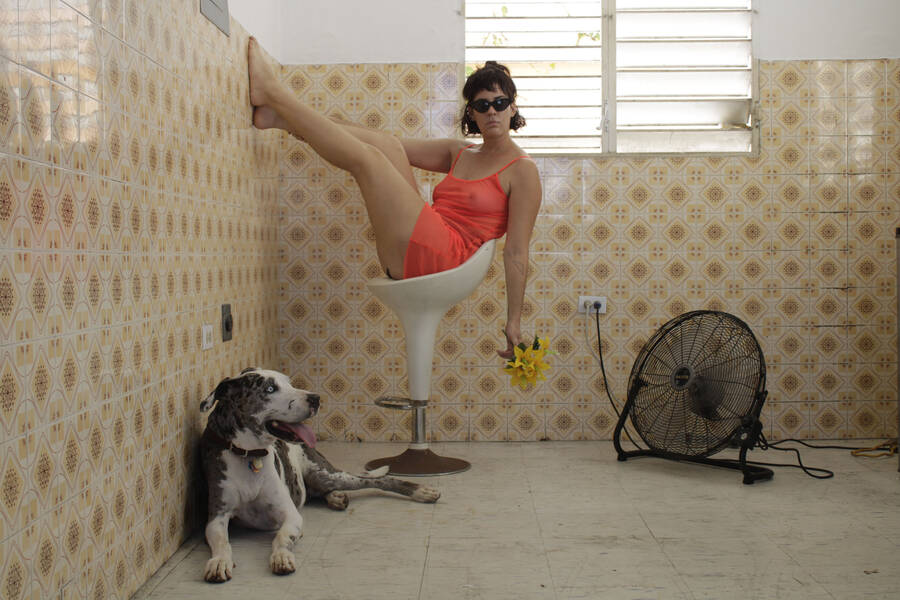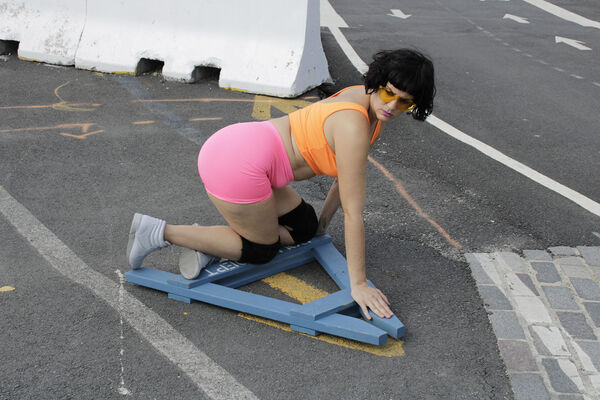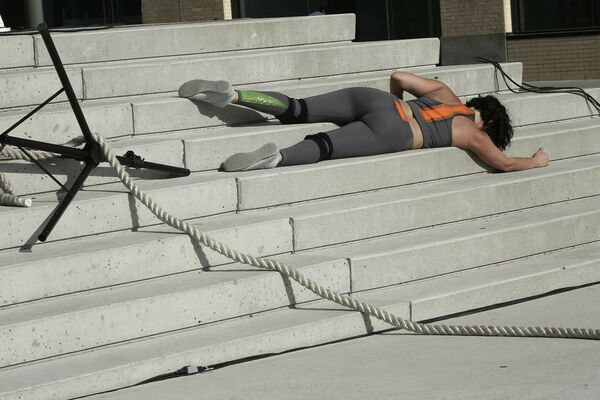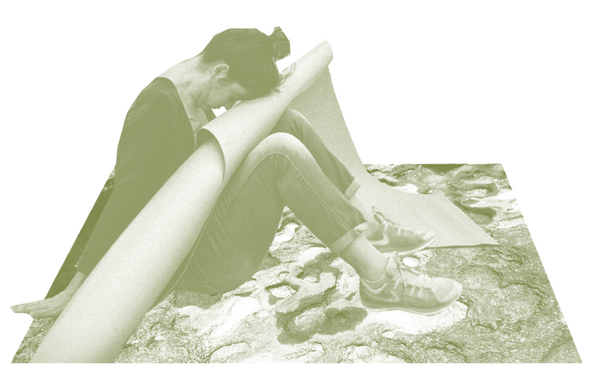
nibia pastrana santiago and Venus (Great Dane): cualesquiera, postcard, 2019, Hidrante, Puerto Rico.
Do Less
nibia pastrana santiago confronts the politics of movement by making dances that refuse to dance.
The relationship between dance and political struggle is often narrated in contradictory ways. In one story, dance is an expression of freedom, a zone of individual and collective release from the bodily constrictions of oppressive systems, a way to rehearse the world we want to see. In another, dance is a site of disciplinary training and the dancer a virtuosic yet docile automaton. Others figure dance in a third way—as an ambivalent practice through which to confront and negotiate corporeal conscription into regimes of domination. nibia pastrana santiago is an interdisciplinary artist based in San Juan, Puerto Rico, whose work dwells in this third, more ambivalent terrain. pastrana santiago engages with political contexts, institutional architectures, and colonial histories in site-specific “choreographic events” that contest the imperialist regulation of public space. For example, in 2014, she staged a series of “body vandalisms”—disrupting the everyday tourist spectacle of US colonialism in Puerto Rico by taking a series of erotically charged selfies among tourists posing with the monuments of US presidents at Paseo de los Presidentes in Old San Juan. During her performance for the 2019 Whitney Biennial, objetos indispuestos, inauguraciones suspendidas o finales inevitables para un casi-baile (indisposed objects, suspended inaugurations or inevitable endings for an almost dance), she interrogated what constitutes the inside and outside of an American art museum, literally disassembling the museum—taking off wall panels, dismantling sound and light infrastructures—and puncturing the institution’s borders by enacting durational improvisations on the surrounding sidewalks and in nearby parks.
Sometimes pastrana santiago confronts the politics of movement by making dances that refuse to dance. In pieces such as the lazy dancer (2013)—reprinted here—and her participatory workshop taller de nada/workshop on nothing (2015), she turned to rest, stillness, and laziness to reject late capitalist calls for the perpetual motion of hyperproductivity. In Sit-uations (2022), written for this magazine, pastrana santiago offers the reader three experimental exercises for sitting, echoing the leftist avant-garde art collective Situationist International’s call to interrupt the smooth function of capitalist productivity by creating moments of drift or wandering, and transposing it to the horizontal register of idleness. The performance studies scholar Sandra Ruiz writes that anticolonial Puerto Rican performance can be a “means to ride out the inexhaustible constraints of one’s life under limited self-control in a nonstop state of economic and political impotence.” Through her work, pastrana santiago records the exhaustion that arises from these inexhaustible constraints and choreographs a slowdown. Her performances are an invitation to explore what an exodus from compulsory efficiency might look and feel like: Do less, take something apart, fall asleep.
—Ethan Philbrick

Port Practice, Whitney Biennial 2019.
Sit-uations
Three exercises for rest and refusal
In durational performances, I am usually engaged with ways of sitting, or to be more precise, ways of failing at sitting. I create these temporary sit-uations with whatever elements are available to put my butt on. In any sitting sit-uation, it is important to consider how refusing to comply with ordinary modes of sitting can become an act of resistance. How might sitting in a strange manner challenge or shift expectations of behavior, break the proscribed organization of the domesticated body? The weight of one’s body is power; the act of resting always interrupts the rhythm of labor. Let it drop.
I invite you to practice some of these exercises. I recommend expending the least possible physical effort and having a glass of water ready to drink when you’re done. You can select one of these sit-uations, or try out all of them, but if you find yourself becoming productive in the task, please pause . . . breathe and rest.

nibia pastrana santiago: indisposed objects, suspended inaugurations or inevitable endings for an almost dance, Whitney Biennial 2019.
Let’s Fail
Find a chair. Look at the chair. Consider its position in space. When you’re ready, lay the chair on the ground, with either its side or back against the floor.
Now, with the chair in this new position, sit on it in any way you like. You’ll probably find yourself closer to the floor. Let your head rest. Let your body find comfort. Is this sitting? Considered from another perspective, it might look like you have fallen.
Continue to lay there and enjoy the chair’s companionship. When you’re ready to leave this position, do so. Drink water.
Sit-uating In Between
Wherever you are, take a look around and identify heavy objects in the space that are within reach of other such objects (e.g., a desk, sofa, planter, stove, etc.). When you feel an impulse, move toward one of these objects. Lie or stand near it. Recline your head against it. Continue to test how much weight the object can hold.
Once you are comfortable, reach toward another heavy object that is close by and find support. Repeat this step at least one more time—extending another body part toward another nearby object, so that your body has at least three points of contact with three different objects.
In this sit-uation you are occupying the space between things. Just be there. Close your eyes and feel the distance from your head to your hands, from your hands to your feet. Breathe. When you’re done, open your eyes, let your gaze wander. Slowly stand up. Drink water.
Movement+ Memories + Dance
Consider different ways you sit in your daily life. You might remember the way you sit in the car, the train, or at the dining table. Holding those memories, sit against a wall in any way you desire. Then, letting those memories guide your movement, change your position, slowly shifting your body into a different configuration in relation to the wall and the floor. Let go of the notion of verticality (e.g., you can sit with your back to the floor and your legs on the wall).
Proceed with the movement, folding in different memories of daily sitting. Find flow as you develop this exercise. Consider closing your eyes. Think of this not as sitting, but as a dance. Dance as long as desired, then stop. Slowly stand up. Drink water.
(nibia pastrana santiago, 2022)
The Lazy Dancer

Port Practice, Whitney Biennial 2019.
First, I am going to make an effort to be lazier.
The lazy dancer has no duty to dance.
The lazy dancer does not stand in the way of progress.
The lazy dancer is in idle state until desire to dance appears.
The lazy dancer does not consider dance as a necessary means to a livelihood.

This may or may not be a true story or a lesson in resistance, postcard, 2020. Commissioned by de Appel. Designed in collaboration with bend (Athens).
For the lazy dancer boredom is risky as it might tempt the dancer produce something. According to general knowledge a dancer must repeat and exhaust themselves in order to acquire the desired technique; a dancer must dance in order to have profit. Contrary to these beliefs, the lazy dancer never dances for the sake of something else.
In regards to the audience, the pleasure of audiences has become mainly passive. Audience members are workers too and often tired they fall asleep during performances. Sleeping becomes the device through which they can derive whatever happiness they may enjoy. In this case the lazy dancer should not make any effort to get their attention, and never resort to virtuosity to wake them up.
In regards to the choreographer, if a choreographer preaches about the dignity of the dancer’s labor, a lazy dancer should abandon the room. As this emphasis on keeping the dancer happy is a strategy to support the choreographer’s own idleness.
In regards to the critic, everyday has the potential to be a dance holiday. Please take a day off.
In regards to the artistic directors, there is no desire to make further comments.
(nibia pastrana santiago, 2013)
nibia pastrana santiago is an artist, choreographer, and educator who develops site-specific choreographic events to experiment with time, fiction, and notions of territory. Since 2020, she has been co-director at Beta-Local. She lives with her family in San Juan, Puerto Rico.
Ethan Philbrick is a cellist, writer, and artist. Philbrick holds a PhD in performance studies from New York University and his first book, Group Works: Art, Politics, and Collective Ambivalence, will be published by Fordham University Press in April 2023.

